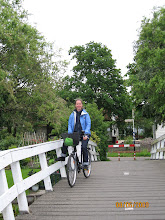Leicester
A wonderful, comfortable, friendly small city (pop. 300,000)
with it all, in my opinion: an extensive
pedestrianised shopping area in the city centre, great Indian restaurants, interesting historic bits, and comprehensive
bicycle infrastructure where you need it, though nothing particularly
flash.
I was in Leicester for the weekend for the annual Building
Cycling Cultures conference, this year held in conjunction with the annual
Riverside Festival.
Leicester has three great assets for a cycling city:
1. Large scale pedestrianisation (luckily completed just before the GFC) making
the central shopping area not just attractive, but easy and quick to get around
– no waiting at traffic lights! The
decision was made not to exclude bikes from the pedestrian areas, and to use
contra-flow lanes on many of the one-way streets that feed into the centre.
2. The size of Leicester means that 90%
of residents live within a 5km radius of the city centre.
3. They have been steadily adding bicycle infrastructure for 25 years, so they
have a good, usable network, consisting of off road paths, shared pedestrian
areas, contra-flow lanes and clever connections and crossings at junctions,
signposting and on-road bike logos, and some bike lanes. It’s not a spectacular or particularly
visible network, but it works well where you need it. I like the attention to detail. I didn't get as many photos as I would have liked - too busy with the conference, such good (distracting) conversation on the ride, and the rain the rest of the time, but here are a few.
 |
| Large scale pedestrianisation in the centre |
 |
| The clocktower |
 |
| Thoughtful provision at junctions and on one way streets |
 |
| An extensive off road network along the River Soar and canals |
 |
| As well as separated paths along roads and shared paths in parks |
 |
| With a subtle reminder, in this plaza, that bikes are permitted. |
The current main focus in
Leicester now is on social programs: cycle training; working
with schools on travel planning in a partnership with Sustrans; the Cycle
Champions project (community development programs to increase cycling in
different cultural and disadvantaged communities in partnership with CTC); and
a regular program of led rides in partnership with British Cycling and SkyRide. Partnerships are key to all these programs.
Leicester has two more special features. It has a
Bike Park right in the centre of
town, in the basement of the town hall, run by a social enterprise,
FutureCycles. It has secure bicycle parking, showers &
lockers, and a bike mechanic and shop.
 |
| Leiecester Bike Park - picture by Rob Marsh from PictureNation |
And, new to me, a Cycle Speedway, where fixies race on a
short oval dirt track with hundreds of spectators in the stands.
 |
| Leicester Cycle Speedway |
Building Cycling Cultures Conference
At the conference we heard from organisations including De
Montford University, Cycling England, Leicester Forest Cycling Club and the
Post Office on their efforts to increase cycling with various programs. My favourite two presentations were firstly,
from photographer Iain Jacques on the architecture of the motor age; and from
David Dansky on Road Danger Reduction.
David spoke about his cycle training for driving which is being
delivered to professional drivers as an option for the new EU Certificate of
Professional Competence requirements, funded by TfL. And for drivers of a minicab company as a PR
rescue after anti-cyclist comments by the boss.
I’d like to explore the possibilities of doing something similar in
Sydney (Len and Patrick take note).
(Thanks to Iain Jacques for a
photo of me giving my presentation)
I was also able to enjoy the
Art House Ride (open houses
displaying works of local artists, sculptors and filmmakers) and the
Tour de Leicester – both magically without rain.
Alongside the conference there was social media training for
community members, by
Citizens’ Eye,
an organisation that trains young people to be Community Reporters – a great,
empowering idea.
Lessons from Leicester
Leicester seems to excel at using partnerships and
supporting social enterprises to magnify what council can achieve on its own,
but with a lot of thought into how to make it work best for Leicester.
The most useful lesson for Sydney, I think, was how
Leicester have built on the SkyRide with their adapted SkyRide Local. The annual mass participation ride (like our
Spring Cycle) is the eye catching one, but to follow up with people who have
taken part, offering them weekly local rides, tailored to local preferences,
with trained (and slightly paid) ride leaders, makes continuing the behaviour
so accessible.
Huge thanks to Andy Salkeld and Janet Hudson for their
hospitality. It was also particularly
good to meet David Dansky (Cycle Training), Elizabeth (Cycle Champion), John
Coster (Citizens’ Eye) and Iain Jacques.
Next: a brief overnighter in Paris before heading to Freiburg.




































